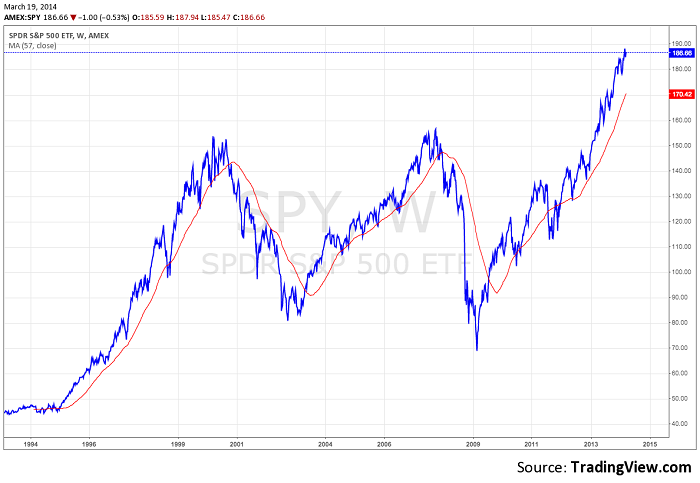Is it possible to invest money and be successful at it, without knowing anything in particular about what you are investing in? In theory yes, and there are people who are successful in this style of investing.
This school of investment thought says that everything is accounted for in the market at any point in time, therefore it is hopeless to try to outsmart the market based on fundamentals. And since the fundamentals are baked in the cake, why bother? The only think investors need to bother with is the trend. If the trend is up, you should be invested, and if it is down, you should either be out of the market or short.
Investors who are trend followers use charts and tools that are designed to show trends. And while there are thousands of technical analysis formulas out there, there is a basic rule of thumb that even the most sophisticated technical investors follow, and that is the 200 day moving average, or 200DMA for short.
The reason why this is such an important technical indicator, is that it signifies the long term trend. And while the long term trend is of little or no importance to day traders or swing (investors who put money to work on a several day basis), it is important to sophisticated institutional investors who do most of the long term buying and selling and who, to a large extent define the trend.
So the question is, can the average investor use the 200DMA to invest money and be successful at it, without following the market on a day by day basis or knowing much about what is going on? In theory the answer is yes, but you need to have discipline.
Let’s look at an example. Suppose you wanted to invest in a basket of stocks as mirrored by the S&P 500. The easiest way to do this is to buy an ETF such as the SPDR S&P 500 ETF (SPY). But the question is, when do you buy and when do you sell? Well, you have to follow the trend.
So let’s look at a simple long term chart with a moving average indicator plotted, that will give you a bird's eye view of the market. As you will see, it doesn't require much time or knowledge to figure out what to do.
Richard Fabian is credited with making the 200 DMA popular in the 1970s. However instead of the 200 DMA, he used the 39 Week Moving Average (WMA) which is identical. But he said that the 52 WMA will produce superior results. I have extended this a little and instead focus on the 57 WMA. The reason is that it gives less fakes signals (also known as a whipsaw). Now let’s look at the chart below.
As you can see, if you bought the SPY ETF around 1995 and held on until about late 2000, having at the same time exited and reentered the market 2-3 times, you made out like a bandit, without really knowing anything about what was going on. At the same time, you were out of the market since 2001 and re entered the market around 2003.
Fabian in the 1970s told his subscribers that they only need to spend a minute a week to determine if they should be in equity mutual funds or cash.
So is it really as simple as this? The answer is no, because you will have fake signals along the way, that will cost you in terms of commissions and capital gains. However, if you can be in the market when it is going up, and out when it dives, the difference over the long term is quite substantial, even with the cost of getting in and out.
The problem with using this or other similar trend following techniques is that they require discipline. Above all, it requires investors to close their ears to the daily noise (if they can) of the market and stay focused on the trend. Believe me, this is not something easy to do. Furthermore, pure trend following investors don’t have an opinion of the market. In fact the more of an opinion you have, the more the chances you will act upon what you think you know and stop following the trend.
Finally, another issue with being a pure trend follower is that it requires experience. Experience is something that no one can teach you, nor can it be embedded in you in any way. It is something you have to gain for yourself.
So remember, if you do decide to follow some kind of trend investment technique, you need to have discipline, you need to follow the trend (no matter what) and in the beginning you will make mistakes, until you gain enough experience in trend following.


WalletHub experts are widely quoted. Contact our media team to schedule an interview.